Contents
Often, gardeners associate magnolia exclusively with a tropical (in extreme cases, subtropical) climate. In fact, such a prejudice about the climatic zones of growing this plant is a delusion. There are more than a dozen varieties of magnolia that can relatively easily endure wintering in temperate and even temperate continental climates. Today, magnolia in the Moscow region has become as commonplace as honeysuckle, fir, thuja or the same peaches. The article considers the cultivation of magnolia in the Moscow region, describes the features of planting and caring for the plant, and shows its photo.
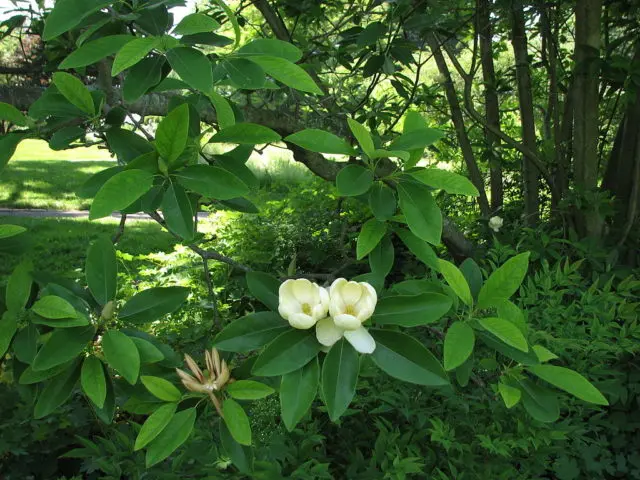
Does magnolia grow in the suburbs
There are no reasons why magnolia could not grow in the Moscow region, except for the relatively harsh winters for this plant species. Other climate features: humidity, duration of the warm season, wind direction, etc., do not have a special effect on the life cycle of magnolia and are not an obstacle to its cultivation.
According to gardeners’ reviews, magnolia specimens growing in the Moscow region are no different from their subtropical counterparts. Neither the growth, nor the timing of flowering plants, nor its intensity is reduced in comparison with the “southern” cultivation.
Some features of the adaptation of young plants and plants that have undergone transportation and transplantation to new climatic conditions are noted. These features consist in the fact that the first 2-3 years the flowering period and its intensity are significantly less than they should be in magnolias growing in their homeland.
In addition, plants, even those with high frost resistance, can suffer significantly from frost in the first years of their life in a cold climate and can hardly tolerate frosts even less than those declared for the variety.
However, already in the 4th year of life, the plant comes into a form characteristic of “cold” cultivation – the flowering time is stabilized, the bark of the plant and its wood thicken, and it turns out to be completely adapted to the new living conditions.
With proper observance of the agricultural technology of the plant, there are practically no cases of death of magnolias from hypothermia in the winter.
Magnolia varieties for the Moscow region
The main criterion for choosing a variety of magnolia for growing it in the Middle lane is the frost resistance of the plant. In order to guarantee a plant that can endure the winter near Moscow, you should pay attention to varieties that have a frost resistance class of 3 to 5. Such plants are able to withstand negative temperatures from -40 ° C to – 29 ° C.
Other varietal qualities do not play a special role, since the climate of the Moscow region as a whole is able to provide normal vegetation and flowering for the plant. In most magnolias, the duration of flowering does not exceed 1 month, and its beginning occurs at the end of spring. The climate of the Middle Strip is enough to provide the required number of warm days.
The following are the most acceptable frost-resistant magnolia varieties that can be recommended for cultivation in the Moscow region.
Kobus
It is considered the most unpretentious variety, from the cultivation of which one should begin “acquaintance” with magnolias in the Moscow region. The variety can grow in the 3rd frost resistance zone, that is, withstand temperatures up to -40 ° C.
This is one of the tallest such crops that can be found in Our Country. The height of adult trees, even in the conditions of the Moscow region, reaches 12 m. The flowers of the kobus are relatively small – their diameter ranges from 8 to 10 cm. A photo of the kobus magnolia tree and flowers is given below.

Magnolia Lebner
A plant that is a hybrid of kobus and star magnolia. Similar to one of its parents, it can withstand temperatures up to -40 ° C. It is distinguished by annual flowering stability (the beginning of flowering occurs in May, the duration is up to 25 days).

The plant has white flowers with long and thin petals. The diameter of the flowers is up to 12 cm. Flowering occurs even before the leaves appear on the plant.
magnolia wilson
A tree up to 10 m high, with a relatively dense crown 3-4 m in diameter. It has long and narrow leaves (up to 18 cm long, 3-5 cm wide) and brownish-red bark. The frost resistance of the plant is sufficient for the middle band – “Wilson” can withstand frosts down to -35 ° C.
The flowers are white, having from 9 to 15 petals, the diameter of the flower is up to 12 cm. A distinctive feature of this variety is the original arrangement of the central part of the flower. In addition, the flowers are always inclined towards the soil, and they can only be seen from below.
The beginning of flowering falls on the first decade of June.
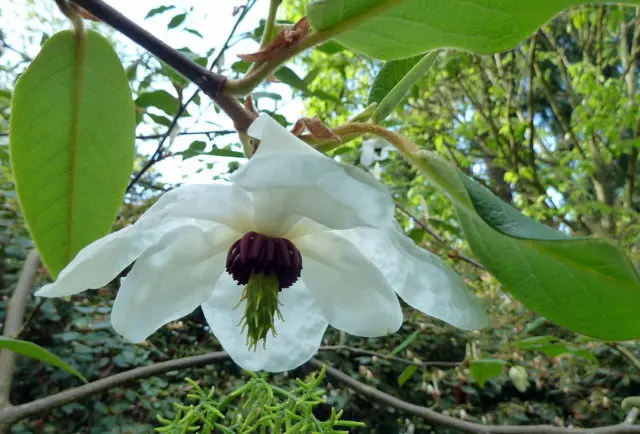
Magnolia Ziebold
Deciduous shrub with funnel-shaped crown. Plant height can reach 6 m. It has elliptical leaves up to 15 cm long, pointed at the end. The color of the leaves is green-blue, changing to bright yellow in autumn.
The flowers are medium in size, 7 to 10 cm in diameter. They have white-yellow petals and characteristic red stamens. The smell of the flower is pleasant, spreading over a long distance.

The plant belongs to the 5th zone of frost resistance and is able to withstand temperatures up to -30 ° C. However, it may suffer from late frosts, so it is advisable to cover the shoots of young shrubs 1-2 weeks before bud opening. Flowering occurs in late June or early July and lasts up to 3 weeks.
Magnolia Esha
A large shrub, in some cases a tree, up to 8 m high. Usually, the “woody” form occurs in plants that received sufficient care and nutrition in the first years of their life. It has a dark gray bark, young shoots are green with pubescence.
The plant is very decorative. The shape of the leaves is very specific and is one of the characteristic features of the variety. The leaves are very large (70 cm long and about 30 cm wide), ovate with two lobes and a wavy margin. They are located on petioles up to 10 cm long. The flowers can be very large (more than 20 cm in diameter), white.
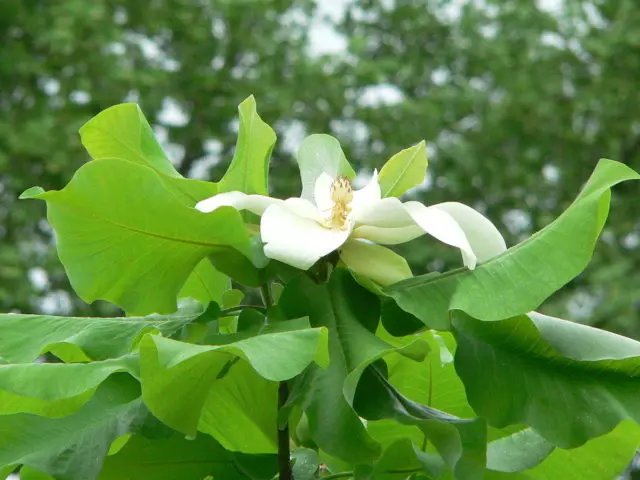
Flowering lasts about three weeks and occurs at the end of May. The frost resistance of the plant is -25 ° C, it takes root well in the middle lane, however, in harsh winters, the shoots need shelter.
Planting and caring for magnolia in the Moscow region
Planting magnolia in the Moscow region does not contain any specific features and, in general, is very similar to the process of subsidence of apple or pear trees.
On the other hand, in the Sun, young plants are often prone to burns. Thus, the best option for a plant to stay in the garden is partial shade.
When to plant magnolia in the suburbs
Landing can be done almost the entire warm season – from mid-March to the end of September. There are no special restrictions or recommendations on planting time for the plant.
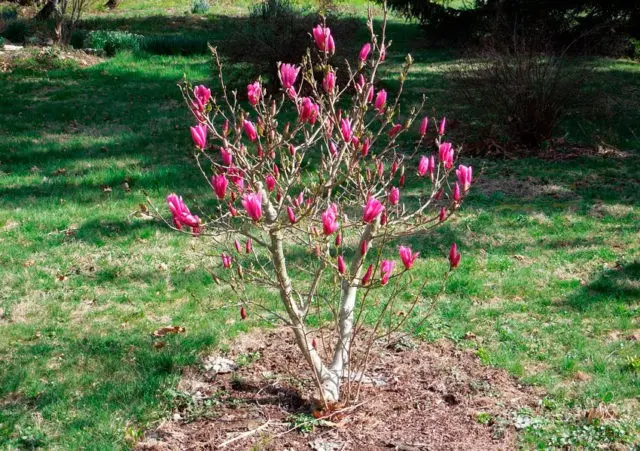
This is primarily due to the fact that magnolias in the Moscow region in the form of seedlings are always supplied in pots or containers, so the root system practically does not receive injuries during transplantation.
Site selection and preparation of soil
It is best to provide the plant with partial shade by planting it in the shade of a large coniferous tree. If there is none nearby, you can use the shade of a large ash or poplar tree. In extreme cases, you can use nearby buildings. But at the same time, magnolia should be positioned in such a way that it is exposed to sunlight for at least 4-6 hours.
It is best to plant in light to moderately moist soil.
Recommended soil composition:
- garden soil – 2 parts;
- peat – 1 part;
- humus or compost – 1 part.
Planting magnolia in the suburbs
In order to plant a tree, it is recommended to dig a hole three times the volume of the earth clod that comes with the seedling.
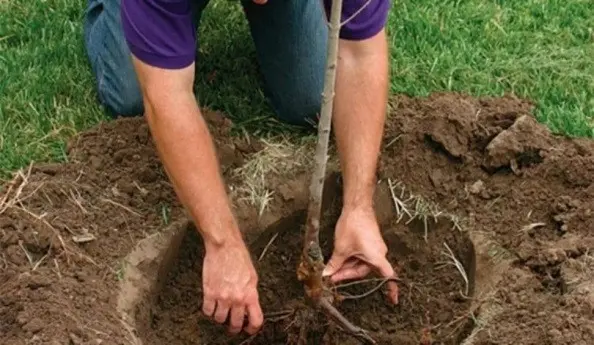
At the bottom of the pit, it is recommended to put a layer of rotted manure 5 cm high. Next, the pit is covered with previously prepared soil and a lump with roots is placed on it.
After installing the seedling in the pit, it is filled up, the topsoil is compacted and moderate watering is carried out.
How to grow magnolia in the suburbs
Magnolia care is quite simple: it includes watering and top dressing, as well as sanitary pruning of the plant.
Watering
Watering is carried out every 2-3 days in the amount of 20 liters for one bush or tree.
Additional fertilizing
The first feeding of the plant is carried out 2 years after planting. In the future, top dressing is carried out twice a year: in early spring and in mid-summer.
The composition of the feed mixture is as follows: 10 g of urea, 15 g of ammonium nitrate and 20 kg of mullein are dissolved in 1 liters of water.
Trimming
Caring for magnolia when growing it in the Moscow region does not imply formative pruning of the plant. Both trees and shrubs of magnolia should be subjected only to sanitary pruning – the removal of dried, damaged or frostbitten shoots.
Shelter magnolia for the winter in the suburbs
Magnolia of the above varieties winters without problems in the Moscow region, however, it is recommended for young plants in their first 2-3 years of life to use various shelters made of plastic film or agrofibre.
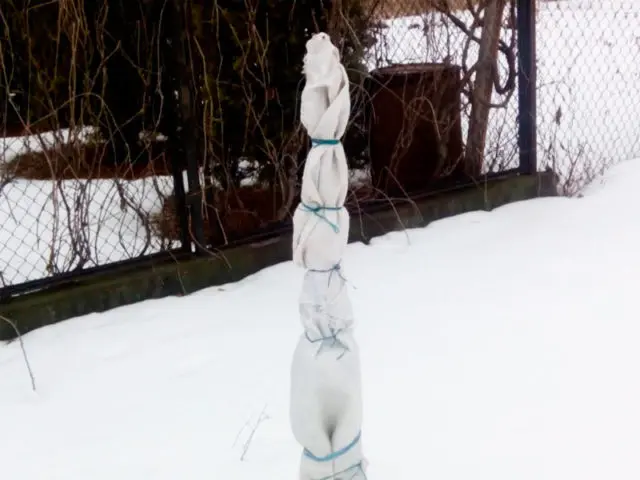
At the same time, it is not even necessary to wrap the plant completely, you can limit yourself only to sheltering the roots and trunk up to the 2nd tier of branching shoots.
Pests and diseases
Gardeners with experience in growing magnolia in the Moscow region note that this plant has fantastic immunity and disease resistance. Practically no cases of plant disease with both fungal and viral diseases have been recorded. Cases of yellowing or blackening of the leaves and shoots of magnolia were caused by thermal burns of the plant (which can happen even in the Moscow region) or its overly active and uncontrolled top dressing.
With pests, the situation is not so joyful, since both the leaves and the roots of an exotic plant appeal to the fauna of the Moscow Region with a very active interest. First of all, it should be noted rodents (from mice to hares), which love to gnaw on the root neck of the plant. In addition, moles are never averse to feasting on delicious magnolia roots.
The fight against these pests is exclusively “mechanical” in nature: plants must be fenced off from the access of large rodents, traps should be set on small ones. The fight against moles on the site is generally a separate topic, which it is not possible to cover within the framework of this article. In any case, the roots and stem of the plant damaged by rodents need to be treated with a solution of foundationol with a concentration of 1%.
Of the arthropods, a special threat to magnolia in the Moscow region is the spider mite, the appearance of which is shown in the photo below.
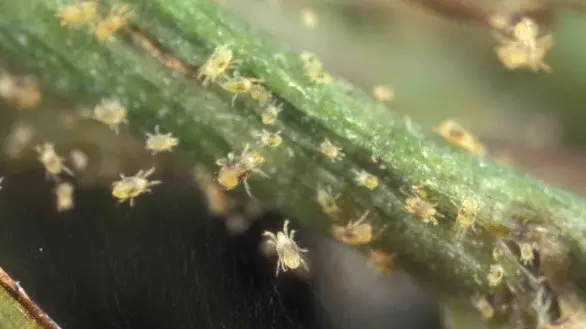
The peak of mite activity falls on the dry period, while the pest hides under the lower part of the leaves. It sucks the juices out of the plant, leading to the death of fairly large magnolia fragments.
The best remedy for spider mites are special preparations used to combat ticks – acaricides, for example, Bicol, Flumite, Apollo. Acaricides are very toxic drugs, so some gardeners do not recommend their use on magnolia. A compromise option is specialized means – insectoacaricides, which are also effective against ticks, but less toxic to flora and humans (Akarin, Karate, Aktofit).
Conclusion
Magnolia in the Moscow region is not a fantasy at all, but a very real situation. The main, or rather the only problem in growing magnolia in the Moscow region is the frost resistance of the plant. If the magnolia can survive the winter, then no other problems due to both climatic and geographical features of the Middle Strip will be an obstacle to its cultivation.









